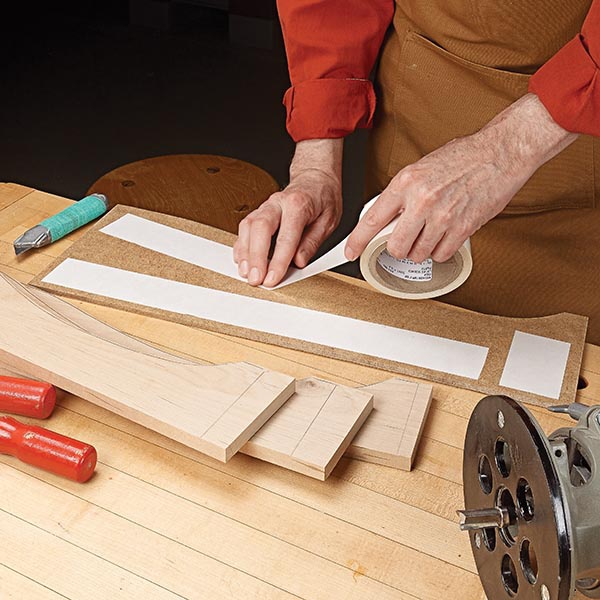Double-Sided Tape
While “carpet tape” has long been a mainstay in many woodworking shops, I have recently become a fan of the double-sided woodworking tape made by Avery Dennison. This tape, shown in use below, has several advantages over standard carpet tapes. Because the two sides of the Avery Dennison tape each use a different adhesive, it excels at attaching a template to a workpiece. One side has a “permanent” adhesive that is fixed to the template first. Then the other less tacky side can be attached to the workpiece. Once in position, the tape allows no lateral movement, but can be repositioned on the workpiece easily. Another advantage of this tape is that it tears conveniently by hand, eliminating the need to track down scissors or a utility knife. Also, it leaves no residue when removed, something that can’t be said for regular carpet tape.

Painter's Tape
Masking tape has all but been replaced by the newer painter’s tapes available today. Because masking tape is notorious for being difficult to remove and for leaving gummy residue on worksurfaces, painter’s tapes are hands down the perfect alternative. Besides being useful for masking off areas when finishing parts, painter’s tape also helps to keep glue squeeze-out off of finished areas when doing assembly work. It can even double as a “clamp” when joining small parts. To prevent tearing out fibers when cutting cabinet-grade plywood, I prefer to use a low-tack painter’s tape like the FrogTape that you see here. This particular tape is labeled as “delicate surface.” It provides a low adhesion to your workpiece and removes cleanly. Simply place the tape, mark your cut line, and make the cut.

SpeedTape
When I don’t want to deal with the hassle of contact cement or a messy spray adhesive, I grab my roll of SpeedTape by FastCap that you see here. This double-sided acrylic tape is incredibly sticky stuff that provides instant adhesion. It sets up to maximum strength within 24 hours. Designed to adhere laminates, veneers, or edge banding to a worksurface, this tape is also strong enough to be used for cabinet refacing. To use, simply apply the tape to one surface, peel off the paper liner and press the material to the tape. A J-roller should be used to apply even pressure over the entire surface.

UHMW Slick Tape
Ultra-high-molecular-weight (UHMW) polyethylene tape is another great product to keep in the shop. This “slick tape” is perfect for making parts slide more easily. UHMW tape is perfect for use with jigs, fixtures, or on the face of a table saw rip fence. It also works wonders on wood drawer runners. It not only makes the drawers function effortlessly, it also helps prevent wear on the runners. As you see here, I like to use UHMW tape on my pipe clamps. It allows me to easily position heavy workpieces for glueup. It also makes glue cleanup a snap. Any glue that squeezes out onto the clamp can simply be “chipped” off with the light touch of a scraper. In addition, the tape keeps unsightly black stains off my workpieces.

High-Friction Guard Tape
This final tape is not really a “tape” in the true sense of the word. There is no obvious adhesive, and it will only stick to itself, not other things. Comprised of a cotton gauze coated with a latex compound, high-friction guard tape is perfect for protecting your fingers when doing carving work. Plus, it holds its shape well, allowing it to slip on and off your fingers easily. Guard tape is also useful for improving the grip on hand tools. The high-friction nature of this tape makes it an ideal wrap.













